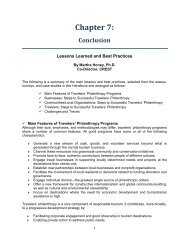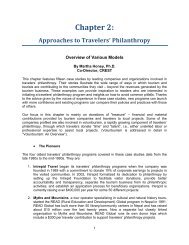Travelers' Philanthropy Handbook - Center for Responsible Travel
Travelers' Philanthropy Handbook - Center for Responsible Travel
Travelers' Philanthropy Handbook - Center for Responsible Travel
You also want an ePaper? Increase the reach of your titles
YUMPU automatically turns print PDFs into web optimized ePapers that Google loves.
8. Institutionalize Regular EvaluationsEnsure that all grants include a clear list of deliverables to enable both self-evaluation by thegrantee and your own assessment of the outcomes. Securing agreement on the deliverablesrequires work with grantees to specify the measurable outcomes needed to achieve their goals.Quantitatively verifiable activities will require per<strong>for</strong>mance indicators or specific deliverables.Qualitative activities will require a description of the desired condition sought. In both cases,identify the means that will be used to verify that the activities have been completed or haveachieved the desired result. Require, in turn, that all monitoring and evaluation outcomes arethen communicated to donors and others via website, newsletters, yearly reports, regularupdates, and routine direct communications.9. Honor the Work of Those on the GroundAs grantmakers, those involved in travelers’ philanthropy projects have a responsibility tomaintain constructive relations with grant-seekers based on mutual respect and shared goals.This involves:• Communicating clearly and on a timely basis with potential grantees.• Treating grant seekers and grantees fairly and with respect.• Respecting the expertise of grant seekers in their fields of knowledge.• Seeking to understand and respect the organizational capacity and needs of grantseeking organizations.• Respecting the integrity of the mission of grant seeking organizations.10. Celebrate the Outcomes and Communicate Them ClearlyCommunicate to your visitors the results of your travelers’ philanthropy projects, through photos,descriptions of the programs, and transparently detailing distribution and reporting mechanismsto ensure donations are properly and effectively used. Ideally, each year, an independentcertified public accountant should review the fund grant records. The travelers’ philanthropyprogress reports and financial statements could be compiled into an illustrated annual reportand posted on the web site. Thus, the visitor can see what was done with his or her help andwhat, collectively with the help of others, their investment accomplished.• ConclusionsThere is no question that leaving something good behind when traveling is fulfilling andmeaningful. However, traveler’s philanthropy will be more satisfying and sustainable if areliable partner is accountable <strong>for</strong> who gets the donation, how it gets distributed, and how itbenefits the community and the resources that may depend on travelers’ support.Success requires an advisory board without local conflict of interest. The best projects operatetransparently so as to limit expectations and avoid creating perceptions of inequity. Ecotouroperators often have most of these elements available because of the nature of their businessand motivation. By rethinking and redesigning the mechanisms <strong>for</strong> giving to make them more<strong>for</strong>mal and effective, more satisfying philanthropy can be established.But what about mainstream tourism? What is the role <strong>for</strong> big outbound and inbound touroperators, hotel chains and resorts, and airlines and other transportation companies? What isthe best mechanism <strong>for</strong> <strong>for</strong>mal philanthropy programs involving the big players in the tourismindustry?23















